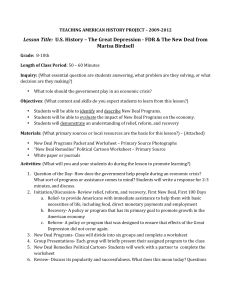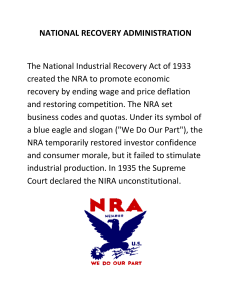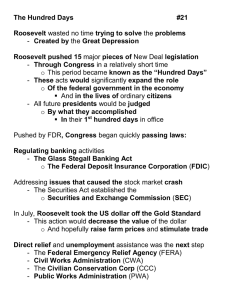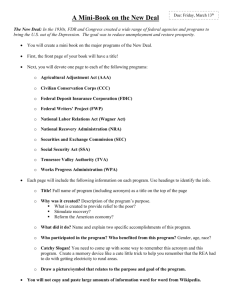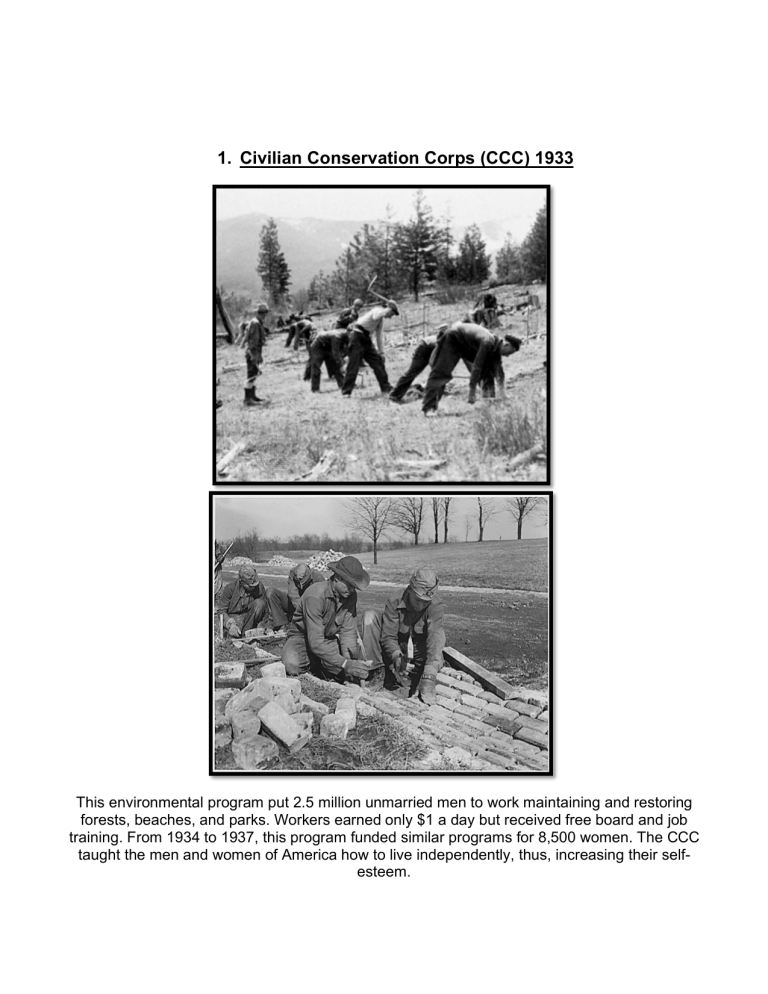
1. Civilian Conservation Corps (CCC) 1933 This environmental program put 2.5 million unmarried men to work maintaining and restoring forests, beaches, and parks. Workers earned only $1 a day but received free board and job training. From 1934 to 1937, this program funded similar programs for 8,500 women. The CCC taught the men and women of America how to live independently, thus, increasing their selfesteem. 2. Agriculture Adjustment Administration (AAA) 1933 The AAA tried to raise farm prices. It used proceeds from a new tax to pay farmers not to raise specific crops and animals. Lower production would, in turn, increase prices. Farmers killed off certain animals and crops as they were told to by the AAA. Many could not believe that the federal government was condoning such an action when many Americans were starving. This was declared unconstitutional later on. 3. National Industrial Recovery Act (NIRA) 1933 The decline in the industrial prices in 1930s caused business failures and unemployment. The NIRA was formed in order to boost the declining prices, helping businesses and workers. The NIRA also allowed trade associations in many industries to write codes regulating wages, working conditions, production, and prices. It also set a minimum wage. The codes stopped the tailspin of prices for a short time, but soon, when higher wages went into effect, prices rose too. Thus, consumers stopped buying. The continuous cycle of overproduction and under consumption put businesses back into a slump. Some businesses felt that the codes were too complicated and the NRA was too rigid. It was declared unconstitutional later on. 4. Federal Deposit Insurance Corp (FDIC) 1934 The Federal Deposit Insurance Corporation (FDIC) was formed by Congress to insure deposits up to $2500. Insured institutions are required to place signs at their place of business stating that "deposits are backed by the full faith and credit of the United States Government." Since the start of FDIC insurance on January 1, 1934, no depositor has lost a single cent of insured funds as a result of a failure. 5. Works Progress Administration (WPA) 1935 This agency provided work for 8 million Americans and attempted to decrease unemployment. The WPA constructed or repaired schools, hospitals, airfields, etc. WPA had employed more than 8,500,000 different persons on 1,410,000 individual projects, and had spent about $11 billion. During its 8-year history, the WPA built 651,087 miles of highways, roads, and streets; and constructed, repaired, or improved 124,031 bridges, 125,110 public buildings, 8,192 parks, and 853 airport landing fields. 6. Social Security Act (SSA) 1935 This act established a system that provided old-age pensions for workers, survivors benefits for victims of industrial accidents, unemployment insurance, and aid for dependent mothers and children, the blind and physically disabled. Although the original SSA did not cover farm and domestic workers, it did help millions of Americans feel more secure. Name: Date:
